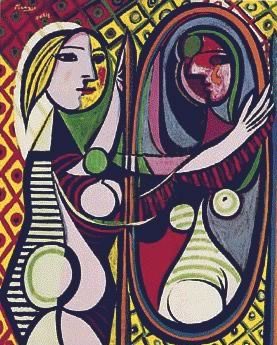Postmodernism
- Keiza Croque

- Apr 26, 2020
- 4 min read
Updated: Feb 15, 2021
What is a postmodernism?

It is a period after modernism, starting from 1970s. Postmodernism can be seen as a reaction against the ideas and values of modernism, as well as a description of the period that followed modernism's dominance in cultural theory and practice in the early and middle decades of the twentieth century. The term is associated with scepticism, irony and philosophical critiques of the concepts of universal truths and objective reality.

The term was first used around 1970. As an art movement postmodernism to some extent defies definition – as there is no one postmodern style or theory on which it is hinged. It embraces many different approaches to art making, and may be said to begin with pop art in the 1960s and to embrace much of what followed including conceptual art, neo-expressionism,feminist art, and theYoung British Artists of the 1990s.
Postmodern vs Modern

Postmodernism was a reaction against modernism. Modernism was generally based on idealism and a Utopian vision of human life and society and a belief in progress. It assumed that certain ultimate universal principles or truths such as those formulated by religion or science could be used to understand or explain reality. Modernist artists experimented with form, technique and processes rather than focusing on subjects, believing they could find a way of purely reflecting the modern world.
While modernism was based on idealism and reason, postmodernism was born of skepticism and a suspicion of reason. It challenged the notion that there are universal certainties or truths. Postmodern art drew on philosophy of the mid to late twentieth century, and advocated that individual experience and interpretation of our experience was more concrete than abstract principles. While the modernists championed clarity and simplicity; postmodernism embraced complex and often contradictory layers of meaning.
The Many Faces of Postmodernism
Anti-authoritarian by nature, postmodernism refused to recognize the authority of any single style or definition of what art should be. It collapsed the distinction between high culture and mass or popular culture, between art and everyday life. Because postmodernism broke the established rules about style, it introduced a new era of freedom and a sense that ‘anything goes’. Often funny, tongue-in-cheek or ludicrous; it can be confrontational and controversial, challenging the boundaries of taste; but most crucially, it reflects a self-awareness of style itself. Often mixing different artistic and popular styles and media, postmodernist art can also consciously and self-consciously borrow from or ironically comment on a range of styles from the past.
Jacques Lacan
Jacques Lacan (1901–1981), was a prominent French psychoanalyst and theorist. His ideas had a huge impact on critical theory in the twentieth century and were particularly influential on post-structuralist philosophy and the development of postmodernism. Lacan re-examined the psychiatry of Sigmund Freud, giving it a contemporary intellectual significance. He questioned the conventional boundaries between the rational and irrational by suggesting that the unconscious rather than being primitive, is just as complex and sophisticated in its structure as the conscious. He proposed that the unconscious is structured like a language which allows a discourse between the unconscious and conscious and ensures that the unconscious plays a role in our experience of the world.
Postmodernism Artworks

Roy Lichtenstein - Whaam! 1963
Pop artists broke down the separation between fine art and popular culture in their work: Lichtenstein borrows the language of comics for his painting Whaam.

Guerrilla Girls - Do Women Have To Be Naked To Get Into The Met. Museum? 1989
In the 1970s women artists began to make art in response to the developments in feminist theory. They used their personal experiences of being women to inform their work.

Sandro Chia - Water Bearer 1981
Neo-expressionism saw painters returning to mythical and historical subjects (in reaction to the negation of the subject by modernist painters). It was anti-intellectual and individualistic and referenced earlier painting styles.

Gilbert & George - Gordon's Makes Us Drunk 1972
Performance allowed artists to create work that eliminated the need for process and technique and also offered a way of making art more accessible to the masses. In this performance Gilbert & George’s deadpan expressions and repeated declaration that 'Gordon's makes us very drunk' creates an absurd scene that ironically questions identity, nationality and 'good behavior'.

Joseph Kosuth - Clock (One and Five), English/Latin Version (Exhibition Version)1965, 1977
Conceptual artists reacted against the modernist emphasis on the importance of the art object. Instead they emphasized the idea or concept behind the work. In doing so they championed the postmodern approach of interpretation and experience over universal truths.

Damien Hirst - Away From The Flock 1994
The YBAs stormed the art world in the 1980s and became known for their openness to materials and processes, shock tactics and entrepreneurial approach. In true postmodern spirit, no one style is evident in their work, though certain shared approaches can be seen such as the use of appropriated objects and images.

Jeff Koons - New Hoover Convertibles, Green, Red, Brown, New Shelton Wet/Dry 10 Gallon Displaced Doubledecker
1981–7
In 1980 Koons exhibited a series of sculptures comprising of wall-mounted vacuum cleaners displayed in Plexiglas cases. Over the 7 years the artist produced several more configurations, using ready-made objects in the creation of highly conceptual artworks. Referred to broadly as ‘The New’ these works explored the way our fantasies and desires are transferred on to ordinary objects. Suspended in a state of ultimate perfection, Koons commented "if one of my works was to be turned on, it would be destroyed."







Comments